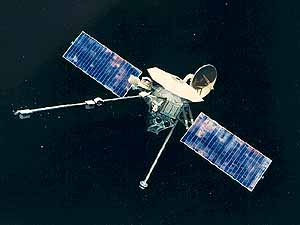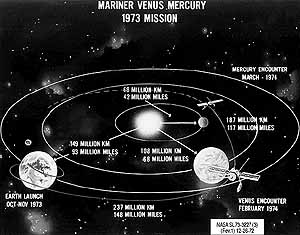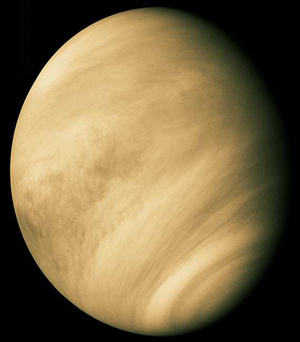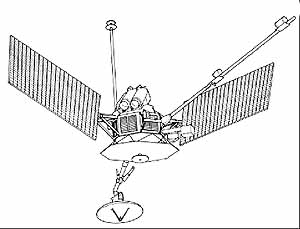Mercury Transit on May 7, 2003 Mariner 10 at Mercury Discovering Mercury For a long time, the planet Mercury remained a mystery. Studying it through telescopes was (and still is!) very difficult because it is so close to the Sun that it is usually lost in the solar glare. When the planet is visible near the horizon, just after sunset or before sunrise, it is often obscured by haze and dust in our atmosphere. Even the best telescopic views show Mercury as an indistinct object without surface details. So, how is this planet like? Which formations are present on its surface? How hot is it and has it a magnetic field? These were some of questions posed by earlier generations of astronomers. We now know some of the answers. In 1974, NASA's spacecraft Mariner 10 arrived at the small planet to photograph the surface and to study the conditions there. To some surprise, Mercury was found to be covered with craters, much like the Earth's Moon. Many other important observations were made by the various instruments on-board Mariner 10. On this page, you can read more about the very successful Mariner 10 mission. The Mariner 10 spacecraft |  |  | | The Mariner 10 spacecraft (left) and its trajectory towards Venus and Mercury. |
NASA's Mariner 10 mission was the first planetary mission to Mercury . The goal was to take pictures of the planet during three separate flyby's in 1974 and 1975. The spacecraft also had the task of observing the Earth's sister planet, Venus , en route. In fact, Mariner 10 used Venus' gravitational field to perform a "gravity-assist maneuvre" which slowed it down and changed its trajectory so that it would fly towards Mercury. This was the first time this technique was used. It is now standard for all spacecraft flying to other planets, except to the Earth's "neigbours", Venus and Mars, to which they can fly directly. Mariner 10 was the seventh successful launch in the Mariner spacecraft series. The on-board instruments were designed to measure the atmospheric, surface, and physical characteristics of Mercury and Venus. The experiments included television photography, magnetic field and plasma measurements, infrared radiometry, ultraviolet spectroscopy, and radio science detectors. An experimental X-band, high-frequency transmitter was flown for the first time on this spacecraft. From Venus to Mercury |  |  | | Images of Venus (left) and Mercury (right, mosaic), obtained by Mariner 10. |
Mariner 10 was launched on November 3, 1973, from Kennedy Space Center in Florida (USA). Its first planetary encounter was with Venus on February 5, 1974 , cf. the trajectory diagram (above). Mariner 10 took some 4,000 photos of Venus at a distance of 24,000 kilometers. Using a near-ultraviolet filter, it secured the first clear pictures of the Venus clouds and it also performed other, specific atmospheric studies. After the Venus flyby, Mariner 10 continued towards Mercury, which it passed on March 29, 1974 , only 705 km above the surface of the planet. Photographs taken during this close approach revealed an intensely cratered, Moon-like surface and a trace of atmosphere - a trillionth (10 -12 of the density of Earth's atmosphere - composed mainly of the noble gases argon, neon and helium, resulting from solar wind bombardment. The pictures also showed huge cliffs criss-crossing the surface of the planet. They were apparently created during an early phase when Mercury's interior cooled and the planet shrank in size, buckling the planet's crust. The cliffs are up to 3 kilometers tall and some are as long as 500 kilometers. Following the first Mercury flyby, Mariner 10 entered solar orbit. However, clever trajectory planning allowed it to rendezvous two more times with Mercury. A second encounter occurred on September 21, 1974 , at an altitude of about 47,000 kilometers. The sunlit side of the planet and the south polar region were photographed. The third and final Mercury encounter was on March 16, 1975 , at an altitude of only 327 kilometers. About 300 additional photographs were obtained together with measurements of the magnetic. Mariner 10 was "switched off" on March 24, 1975 when its onboard fuel was depleted. The mission cost was about 100 million US Dollars. The Mariner 10 Spacecraft |  | | Sectional view of Mariner 10. |
The Mariner 10 spacecraft weighed 503 kilograms. Its body had an octagonal structure of magnesium and aluminum with eight electronics compartments. It measured 140 cm diagonally and was 46 cm high. The spaceprobe was 3-axis stabilized by means of cold gas thrusters. It had two solar panels, each measuring 2.7 x 1.0 m; they were attached at the top and supported 5.1 square metres of solar cells. These produced a maximum of 540 Watt. Mariner 10 also carried NiCd batteries with a capacitity of 20 Amp-hours. Communication with the Earth was done in the S- and X-bands. For this, Mariner 10 carried a low-gain omnidirectional antenna, composed of a honeycomb-disk parabolic reflector measuring 137 cm in diameter. The payload contained the following science instruments: Twin narrow- angle cameras with digital tape recorders, ultraviolet spectrometer, infrared radiometer, solar plasma science experiment and charged particle detector. The spacecraft also carried a star tracker (guiding of the bright southern sky Canopus) located on the upper ring structure of the octagonal satellite, and Sun acquisition sensors on the tips of the solar panels. Mariner exploration missions Mariner 10 was part of the successful Mariner series, the U.S. spacecraft that explored the inner solar system, gathering information about Mercury, Venus and Mars. Mariner 2 was the first space probe to successfuly visit another planet. It passed Venus at a distance of about 35,000 km on December 14, 1962. Mariner 4 explored Mars at low resolution in 1965 and sent back images of of a cratered surface, reducing the hopes of "life" on Mars. Mariner 5 landed on Venus in 1967. Mariners 6 & 7 achieved a higher-resolution look at Mars in 1969. Mariner 9 arrived in Martian orbit on November 13, 1971, in the middle of an enormous dust storm which completely obscured the surface for weeks. When the dust cleared it discovered many remarkable surface features, including the 24 km tall (extinct) volcano now named "Olympus Mons" and three times higher than Mount Everest. It mapped entire surface of Mars in 1971 and 1972, sending back 7329 closeup pictures. Finally, Mariner 10 studied Mercury and Venus in 197-75. More information about the Mariner spacecraft series is available at the corresponding NASA Spacelink Mariner site . Future missions to explore Mercury Europeans (ESA) and Americans (NASA) are planning to explore Mercury with new spacecraft. The ESA mission is called BepiColombo and it it planned for 2011-2012. It will include the Mercury Polar Orbiter (MPO) for surface studies, the Mercury Magnetospheric Orbiter (MMO) for magnetospheric studies, and the Mercury Surface Explorer (MSE) for landing. NASA's planned Mercury probe is known as MESSENGER which stands for "MErcury: Surface, Space ENvironment, GEochemistry and Ranging". It will be launched in 2004 and go into orbit around Mercury in September 2009. It will carry seven instruments to photograph and otherwise study this planet. With both of these spacecraft, it is the intention to try to answer some the outstanding questions about Mercury, e.g., as formulated by the MESSENGER team: - What is Mercury's tectonic history?
- Is Mercury's surface shaped by volcanism?
- What is the origin of Mercury's high density?
- What is the nature of the mysterious polar caps?
- What are the composition and structure of its crust?
- What are the characteristics of the thin atmosphere?
- What is the nature and origin of Mercury's magnetic field?
- What are the characteristics of Mercury's small magnetosphere?
|
|
|
| | |